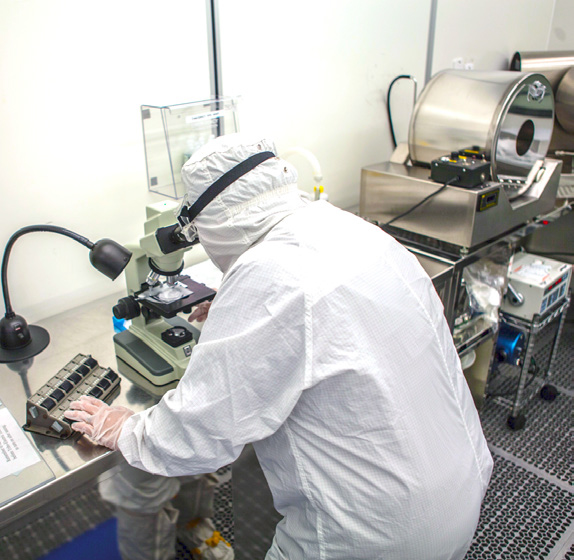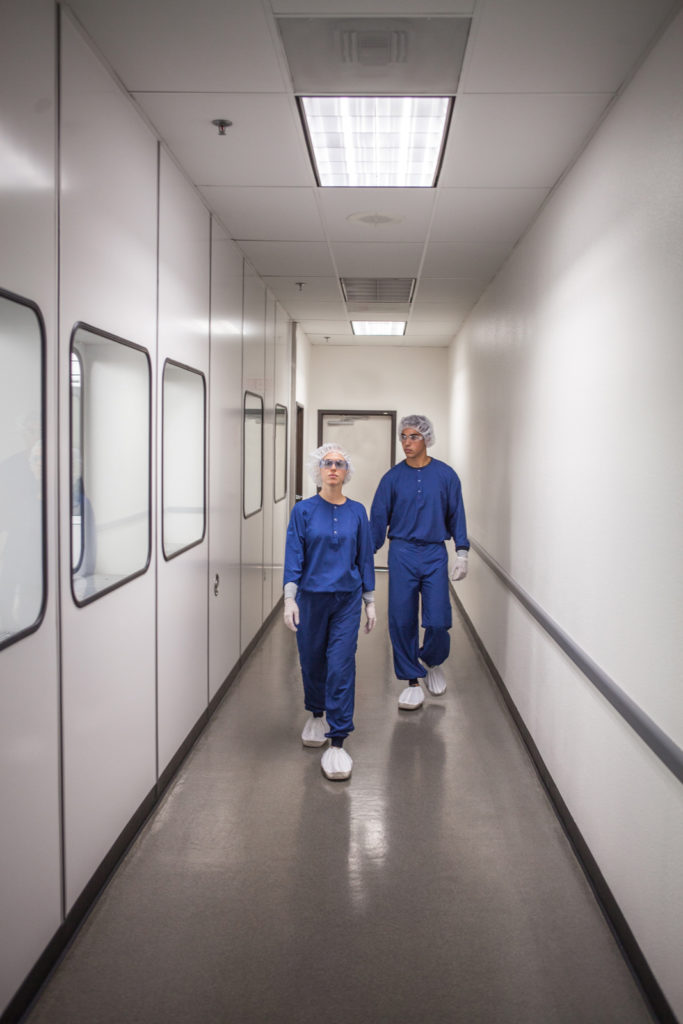Prudential Cleanroom Services sponsored the CPC Laboratories, Inc. Cleanroom Garment Fabric Study that tested eighteen fabrics used in pharmaceutical, biotechnology, electronics, aerospace, medical device, agriculture/food, and other industries that rely heavily on contamination control. These fabrics are used in many types of cleanroom apparel.
The study factored in 16 core criteria and compliance with International Organization of Standardization (ISO) and Occupational Safety and Health Administration (OSHA) cleanroom garments specification requirements.
These are some key features of cleanroom fabric considered in determining the best fabrics for sterile environments, including:
- Electrostatic Discharge (ESD) Properties: Static electricity poses a threat in cleanrooms where sensitive equipment or substances are handled. It can attract contaminants and microorganisms that can be spread.
- Arc Flash Resistance: Arc flashes can cause electrical explosions. Resistant apparel can protect cleanroom employees from extreme conditions. This is important because an arc flash explosion can reach temperatures up to 35,000℉.
- Resistance to Chemicals, Bacteria, and Particles: High-density fabrics prevent chemicals and bacteria from reaching the technician’s skin. A garment with high particle filtration efficiency also filters out particulate matter from the wearer.
- Tear Resistance: A small tear in a uniform can let microparticles escape from the wearer into the cleanroom environment. Resistance to tearing is therefore an essential property for clothing, especially in facilities with more critical ISO classes.
- Non-Linting: Shedding of lint and particles in a cleanroom can cause an unacceptable level of contamination. To prevent this, cleanroom apparel must have continuous filament fabrics with fewer loose ends and a low risk of shedding.
Cleanroom Approved Fabrics
People using a cleanroom are the largest contributors of contamination. Cleanroom apparel must meet requirements of ISO classes ranging from Class 100,000 (ISO 8) to Class 1 (ISO 3). The following cleanroom fabrics are gamma compatible (allowing thorough sterilization) and provide an effective barrier to particles as small as one micron:
- Integrity 1800: Meets the requirements for a Class 10 (ISO) 4 and above. This high-density continuous filament polyester fabric has an ESD carbon stripe, is fluid repellant, and is treated to protect against bacteria, fungi, yeast, mold, and mildew.
- Integrity 2000: When donned with an inner suit, it meets the requirements for a Class 1 (ISO 3) cleanroom and above. Also fluid repellant with antimicrobial properties, it offers splash resistance, static control, and excellent bio-permeation properties. Integrity 2000 is suited for use in semiconductor, microelectronics, and aerospace applications.
- Maxima ESD: With ESD carbon strips, this high-density polyester fabric repels fluid and bacteria, suiting it for pharmaceutical, biological, food processing, and other aseptic environments. It is also static dissipative to a certain degree, supporting use in Class 10 (ISO 4) cleanrooms.
- Maxima® FR: Made of 100% Nomex® fabric, it is non-linting and complies with OSHA safety requirements (regulation 1910.269); it’s also NFPA 70E and ASTM 1506 compliant. Maxima® FR shields against high temperatures and has ESD protection. In addition, it won’t wear out during washing or sterilization.
- Burlington C3: Designed for applications in the semiconductor, laser, microelectronic, and similar industries, this high-density filament polyester fabric contains 1% carbon fiber. It includes ESD gridded stripes. Protection against airborne particles is also provided.
- Chemstat 909/909A: Chemistat 909A contains a tighter material than Chemstat 909, making it suited for Class 10 (ISO 4) cleanrooms. These antistatic fabrics feature an extruded polyester/carbon polymer with a raised conductive grid. The fabric is designed to withstand more than 300 industrial laundering cycles.
- Nomex® (Chemstat 919/487): Containing a 100% multifilament Nomex® fiber, this cleanroom fabric is designed for use in explosive or high heat environments, including NASA refueling and reloading operations. It must be worn with flash flame and arc flash resistant clothing. The fiber has a low flammability level up to 700℉.
- AB 4800: AB4800 fabric offers the greatest value and dependability and is designed for use in cleanroom applications where ESD characteristics are paramount. Fabric is lightweight, proven to be durable and comfortable to wear. AB4800 is woven with 98% polyester / 2% carbon fibers. The ESD fiber is carbon-based and woven in a grid pattern.
- 9. AB 5800: AB5800 fabric offers excellent value and dependability and is designed for use in the majority of cleanroom applications with ESD characteristics and has been proven to be durable. The fabric is a strong all-around performer. AB5800 is a taffeta weave woven with 99% polyester / 1% carbon fibers. The ESD fiber is carbon-based and woven in a grid pattern.
Prudential Cleanroom Services Fabric Study Overview

The CPC study tested numerous fabrics to measure their suitability for applications in the contamination control industry. The information gathered enables us to provide a personalized fabric study to help determine your requirements. Some of the most important apparel characteristics measured include flame retardance, which Nomex® filaments are known for, static dissipation, and comfort. These properties help facilities meet OSHA requirements for protective clothing that shields workers against hazards such as flames and electric arc flashes.
Compliant cleanroom suit material is found in all cleanroom uniforms and apparel supplied by Prudential Cleanroom Services. We provide high-quality sterile and non-sterile garments that are non-linting and liquid- and bacteria-resistant. These include our HDESD fabrics used in Sterile and Non-Sterile applications, consisting of a hood, coverall, reusable face mask, frock, sleeve covers, and knee-high boots.
Testing showed it has excellent filtration efficiency, particle/fiber generation, surface resistivity, static decay time, abrasion resistance, air permeability, water vapor transmission, and antibacterial qualities.
Other Products from Prudential

The AB5800 ESD is another cleanroom uniform we offer that meets the latest cleanroom garments specifications. It features a 99% polyester/1% carbon fiber taffeta weave with a grid of ESD fiber. Our Ground Zero ESD is suited for the most sensitive ESD cleanroom environments, including electronics and semiconductor facilities, and it has a 98% polyester/2% carbon fiber twill weave. The AB4800 ESD has a similar formulation; in addition to electronics, it can be used in laser and medical device applications.
In cleanroom environments where arc flash flames are a risk, we recommend the NFPA 80E FR. It uses multiple fabrics, including Chemstat 919 and Chemstat 487. For inner wear, we stock the ESD Micro Denier, white face masks, and ESD shoe covers, and garment bags are sold individually as well. Visit the product pages to learn more or request a quote, or call Prudential Cleanroom Services at 800-767-5536 to learn more about how we can help support your cleanroom operations.
